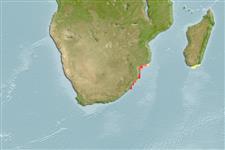Teleostei (teleosts) >
Gobiiformes (Gobies) >
Gobiidae (Gobies) > Gobiinae
Eponymy: Dr John Frederick Croil Morgans was a research assistant at the Zoology Department of the University of Cape Town. [...] (Ref. 128868), visit book page.
More on author: Smith.
Environment: milieu / climate zone / depth range / distribution range
Ecology
Marine; freshwater; brackish; demersal; amphidromous (Ref. 46888); depth range 1 - 16 m (Ref. 28077). Subtropical; 25°S - 31°S
Africa: coastal lakes and estuaries in KwaZulu-Natal, South Africa, and southern Mozambique (Ref. 2798, 52193); also recorded from Madagascar (Ref. 4343).
Length at first maturity / Size / Weight / Age
Maturity: Lm 3.0 range ? - ? cm
Max length : 6.4 cm TL male/unsexed; (Ref. 52193)
Lives in burrows excavated in clean sand, often in association with the sandprawn Callianassa kraussi (Ref. 52193). Restricted to sandy, quiet water areas and is unable to form burrows where the substrate is disturbed by water movements, is muddy or consists of sand with a particle diameter > 0.5 mm (Ref. 28077). Food consists of slow moving benthic organisms like chironomid larvae, gastropods, bivalves and amphipods (Ref. 28077). Breeds throughout summer, males are territorial (Ref. 52193). On exposed shores, they occur deeper than 3.5 m (Ref. 28077, 2798). Occasionally intertidal.
Life cycle and mating behavior
Maturity | Reproduction | Spawning | Eggs | Fecundity | Larvae
Skelton, P.H., 2001. A complete guide to the freshwater fishes of southern Africa. Cape Town (South Africa): Struik Publishers, 395 p. (Ref. 52193)
IUCN Red List Status (Ref. 130435: Version 2024-1)
Threat to humans
Harmless
Human uses
Tools
Can't connect to MySQL database fbquizv2. Errorcode: Too many connections
